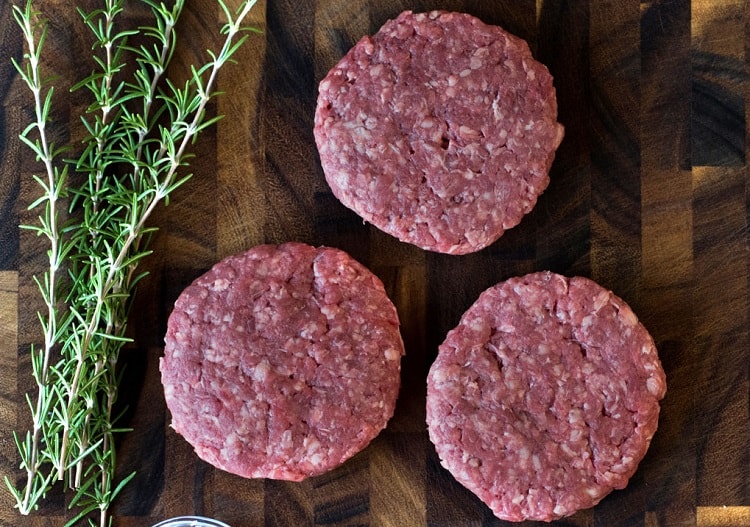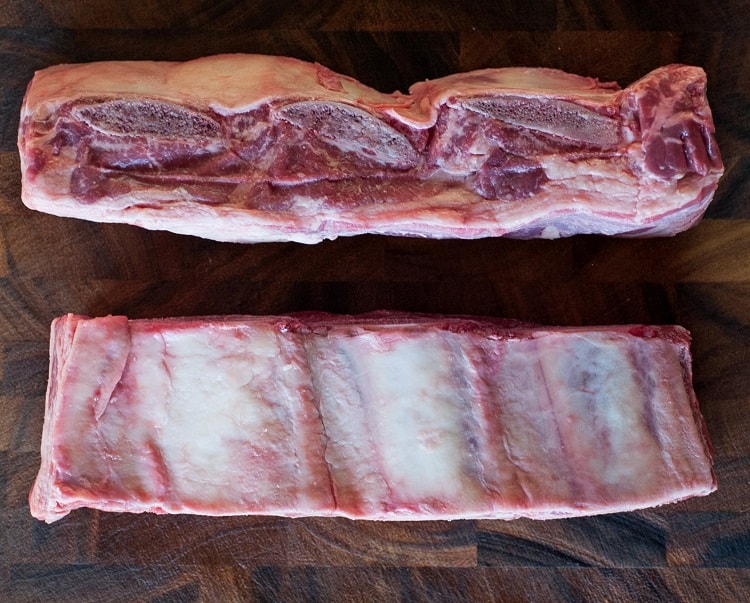- Where to Buy Whole Brisket Online - July 25, 2022
- Skirt Steak vs Flank Steak – Big Differences? - April 6, 2022
- Strip Steak Vs Ribeye: Which is Better for Date Night? - April 2, 2022
Today we will have a look at Richards Grassfed Beef. Is it worth it? Does your purchase of this beef count as an ethical, environmental, and healthy choice? Where can you buy it? And finally, but not least importantly, does it taste good?
Well, the juiciest part of a steak is in the middle so let’s start with the middle question. Does your Purchase of this beef count as an ethical, environmental, and healthy choice? You bet it does! The world needs to take a serious look at their food choices and how those choices affect every aspect of what it means to be a human consumer on this planet.
First, since we are on the topic of beef let’s have a superficial glimpse at the dark side of the meat industry. Some of this may surprise you.
According to www.theworldcounts.com, a site that looks at the human impact on the planet,
- beef production emits 250 times more greenhouse gas per gram of protein than Legumes such as beans or peanuts
- It requires at least 15,500 liters of water to produce 1 kilo of beef.
- The amount of water used for meat production in just 35 hours could provide drinking water for everyone on earth for a year.
In another article on www.rainforestconcer.org, we find that “…for each pound of beef produced, 200 square feet of rainforest are destroyed.”
Once that land has been overgrazed by the cattle the farmers move on to destroy more rainforest leaving behind dry and nutrient-stripped soil that cannot recover because the previous microclimate has been destroyed. This contributes to the desertification of the planet.
The problem with beef production is multifaceted, but if you and your family are carnivores. you owe it to yourself, and to those you will pass this planet onto after you are gone, a hard look into how your food choices affect the world.
There are two ways one can reduce the devastating impacts of beef production. The first one is easy, reduce your consumption of beef products. There are many alternative ways to get protein into your diet.
Secondly, if you choose to consume beef, do your research, and buy from smaller producers that sustainably manage the land rather than destroy it, treat their animals respectfully, and feed their animals a healthy natural diet without the need for GMO grains, broad-spectrum antibiotics, and pesticides.
It can be done and is being done across the US. The added cost (which is not all that much actually) is worth it when you realize that you are providing healthy food for your family and respecting the environment you live in. Remember what they say, “You are what you eat”
To learn more about the ethics and environmental standards of Richards Grassfed Beef click here to see their about page. I think you will feel not only confident in purchasing your beef here, but also proud.
What Does it Mean to Be Grass-Fed?

In the simplest terms, it means the cows are fed what they would normally consume in nature — grass. All cows are grass-fed to some extent but in corporate cattle production, before the cows are sent to auction, they are fed grain — lots of grain. This puts on weight quickly and adds fat to the meat.
The added weight brings more money to the seller and the added fat tastes more satisfying to the buyer. Happy fat cow, happy seller, happy buyer, right? Wrong! Grain is cheap and it is often from genetically manipulated crops. This is not the natural source of food for cows and because it is of poor nutritional value it comes at a cost.
Cows at this point are no longer roaming, they are in a feedlot, standing in their own waste, eating only grain, and getting sick. They are given antibiotics to keep them just healthy enough to keep eating and look good for the market, but all of this is altering the food you are going to consume. It’s not good for the animal, the environment, or you.
So, a label that says “grass-fed” can be added to any beef. Look for “Grass-fed” and “grass-finished”. That gets you a step closer but even then, cleaver producers want your dollars, and they can start cows on grass, feed them grain in the middle, and then set them free in a field just before going to auction.
This alteration in feeding allows them to also say “grass-finished”. It’s wrong, yes, but it’s a nasty greedy game with the big beef producers and all I can tell you is this; YOU MUST DO YOUR OWN RESEARCH! Check the website, read the literature, and watch the reviews of any producer you want to purchase from. The liars will be flushed out into the open eventually.
Now here is a somewhat reliable tip. If the meat is red and the fat is white it’s probably grain-fed. Basically, if it looks like supermarket meat it’s not the meat you should choose. Instead, look for meat that is darker with a more purple tint to it. The fat should also be a little darker and almost a yellow color. There is less fat in grass-fed beef.
Let’s have a look at some of Richards Grassfed Beef click here. You will clearly see what I am talking about. All of these various cuts of beef are more purple, and that fat content is lower than what you see in most supermarkets. This is a fairly reliable clue that your beef is from a grass-fed cow.
Cost

Well, the “middle” of our review/research is heavy, but important. Now, let’s move on and have a look at the cost. How about a 12oz New York Steak? Are you ready (drum roll please)? $18.99. Yes, that is UDS, not Euro. I cannot compare using the names of other vendors or stores, but you know that’s a good deal already. Right?
How about a nice 12oz Ribeye. What would you pay for that? How about $19.99. This is 100% regenerative grass-fed ribeye. It is not the cheapest cut of meat, but you cannot touch that price at the big health food store.
Click here to see the full range of products and prices I think you will be surprised at the affordability of such a high-quality product.
Want to save a little more? Do you have a big family or some friends to share the cost with? You can save hundreds of dollars by ordering in a bulk shipment. Inquire for details on bulk shipping here.
Shipping had been limited to CA only but recently they have expanded shipping to WA, OR, NV, and AZ. The more we support sustainable farming the more they can expand and create real change in the meat industry.
Taste

True grass-fed beef that has been allowed to roam on the land is less fatty and sometimes just a little less tender. This is because these cows are not wasting away and getting fat in a feedlot, they have “real” muscles. That can be an adjustment for some people but it’s not such a large step.
The natural regenerative pasturing that Richards Grassfed Beef is involved with, allows their cows to consume nutrient-rich grasses, and this produces a juicy, nutrient-rich beef. You will, perhaps for the first time, taste truly lean beef. Once you cross over to holistically raised beef, you are likely to lose the taste for grain or corn-finished fatty beef and your body with thank you too.
Richards Grassfed Beef is not sold through 3rd party vendors which means I can’t expand much on “other people’s opinions” but they do have a Facebook page and they have 4.4 out of 5 stars.
Only 3 people clicked the option “do not recommend” but not one expressed why they chose not to recommend so I can offer no opposing views. Not a bad thing by any means we just like to be transparent with opposing views and there are none at the time of this review.
Is it juicy? Yes. it is tender? Yes. Is it fatty? No. Is it tasty? I say yes, but I am also accustomed to whole foods and naturally sourced animal products. I remember my first free-range turkey.
It was different from the sodium enriched supermarket turkey I was used to. At first, I felt slightly cheated at my Thanksgiving dinner because it was not so “plump”, but the flavor was actually richer. Now I will never go back to you know the brand that starts with butter ends with ball. If I keep the words apart, I don’t actually advertise for them. Ha!
Nothing tastes as good as doing the right thing feels…well, except for Richards Grassfed Beef. I do believe you will be very satisfied with all of their beef products.
Still on the fence? Do yourself a favor and order two steaks for your first try. I bet you will place your second order for 10-30 lbs. Yep time to buy a freezer!

Pros
- Supports sustainable farming
- Support local business
- No GMO Grain or cruel animal practices
- Bulk ordering saves time and money
- Grass-fed beef is high in beta-carotene, Vitamin E & B, essential Omega 3 fatty acids, Conjugated Linoleic Acid (CLA), and Trans Vaccenic Acid (TVA)
- Leaner meat than commercially raised beef
- Gift Cards are available
Cons
- Limited shipping to CA, WA, OR, NV, and AZ only
- No returns except for shipping damage or delayed shipping leading to spoilage.
- Low-fat content (pro for most but a con for some)
FAQ’s
Answer: Yes!
Answer: On average when compared to similar products in California Richards Grassfed Beef averages about 30% less and the savings is even better when you buy in bulk.
Answer: Yes, our animals are raised on holistically managed ranches and are monitored to ensure optimal soil health, biodiversity of plant species, and water infiltration. We strive to improve the land we graze, not deplete it! Check out our video on regenerative farming
Answer: Grass-fed beef is high in beta-carotene, Vitamin E & B, essential Omega 3 fatty acids, Conjugated Linoleic Acid (CLA), and Trans Vaccenic Acid (TVA). Because grass-fed animals are naturally leaner, the beef is also lower in cholesterol and calories than commercially raised corn-fed beef. Eating grass-fed beef is the right decision for your health & the health of your family!
Answer: No. From the moment our animals are weaned from their mothers, they consume high-quality grass for the rest of their lives.
Answer: The meat is cut, and vacuum-sealed in see-through packages. This airless environment ensures high quality and long shelf life in your freezer.
Is it Worth it? The Verdict
If you live in California, Oregon, Washington, Nevada, or Arizona, I think you will be satisfied with your purchase from Richards Grassfed Beef. The beef is really of high quality and the nutritional value well exceeds standard commercial beef.
That alone should sell you on this product. Add to that the sustainable practices and you have reason to be proud of the choice you make for the health of your family, the animals, and the planet. Look at the pride of this family member at Richards Grassfed beef. They just have it in their hearts to do the right thing.
Another nice thing they are working on is ensuring all of the remains of the animal can be utilized in continued ethical ways. A recent post on their Facebook page announced that a partnership with Other Half Processing and Land To Market is now sending the Richards Cowhides to places like Timberland Pro to create their first-ever, Regenerative Leather Work Boot.
A big thumbs up to Timberland Pro and to Range Revolution who are looking for better sources for leather.
Richards Grassfed Beef is the first beef company on the west coast to receive the Savory Institute’s Ecological Outcome Verified certificate and is also certified by the American Grassfed Association.
I feel this is a worthy family-run business and I give them a very confident thumbs up for all their environmental efforts and great beef products.
What if You Want Grass-fed, Grass-finished Beef but You Don’t Live in CA, WA, OR, NV, or AZ? I knew you would ask. Don’t worry, if you can’t get the beef you want from Richards Grassfed Beef, I have two resources that will help you find a legitimate source of true grass-fed/grass-finished beef in a location near you.
The first one is www.americangrassfed.org Which is a great resource for finding a grass-fed producer near you. There must be close to 100 farms in the lower 48 states, 1 in HI and even 1 in Puerto Rico. It helps to take the guesswork out of finding quality and ethically procured beef products.
The second is http://www.eatwild.com. This site also offers an easy, search by state for finding local Grassfed meat, dairy, and eggs. They also offer great scientifically-based information and news on food safety, environment, animal treatment, and health.
It is a great site for being informed on the benefits of buying locally from farms that are focused on the health of the planet and the health of the people.
Happy Eating!
For more interesting readings check out:

